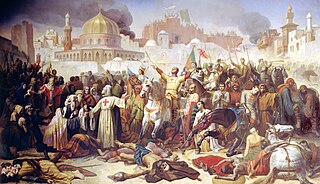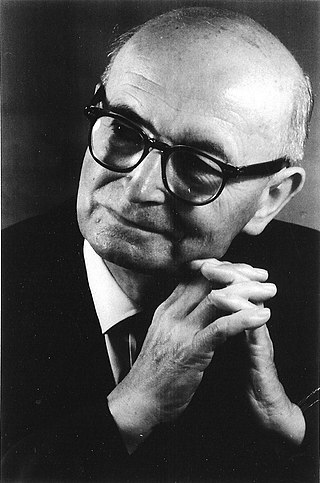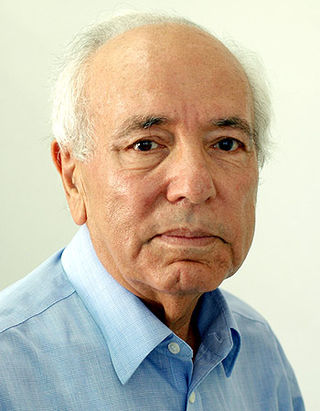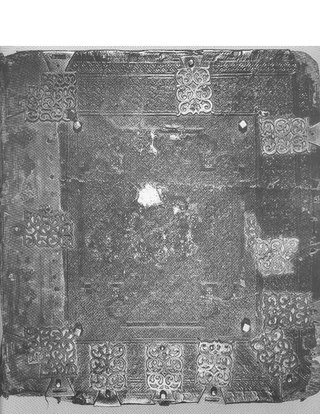
The Fatimid Caliphate was a caliphate extant from the tenth to the twelfth centuries AD under the rule of the Fatimids, an Isma'ili Shi'a dynasty. Spanning a large area of North Africa and West Asia, it ranged from the western Mediterranean in the west to the Red Sea in the east. The Fatimids trace their ancestry to the Islamic prophet Muhammad's daughter Fatima and her husband, ‘Ali ibn Abi Talib, the first Shi‘a imam. The Fatimids were acknowledged as the rightful imams by different Isma‘ili communities as well as by denominations in many other Muslim lands and adjacent regions. Originating during the Abbasid Caliphate, the Fatimids conquered Ifriqiya and established the city of al-Mahdiyya. The Fatimid dynasty ruled territories across the Mediterranean coast and ultimately made Egypt the center of the caliphate. At its height, the caliphate included—in addition to Egypt—varying areas of the Maghreb, Sicily, the Levant, and the Hejaz.

A genizah is a storage area in a Jewish synagogue or cemetery designated for the temporary storage of worn-out Hebrew-language books and papers on religious topics prior to proper cemetery burial.

The siege of Jerusalem during the First Crusade lasted for one month and eight days, from 7 June 1099 to 15 July 1099. It was carried out by the Crusader army, which successfully captured Jerusalem from the Fatimid Caliphate and subsequently founded the Kingdom of Jerusalem. Having returned the city and the Church of the Holy Sepulchre to Christian rule, the siege was the final major armed engagement of the First Crusade, which had been proclaimed in 1095 to recover the Holy Land for the Christians in the context of the Muslim conquest. A number of eyewitness accounts of the battle were recorded, with the most quoted events being derived from the anonymous Latin-language chronicle Gesta Francorum.

Abū Tamīm Maʿad al-Mustanṣir biʾllāh was the eighth Fatimid Caliph from 1036 until 1094. He was one of the longest reigning Muslim rulers. His reign was the twilight of the Fatimid state. The start of his reign saw the continuation of competent administrators running the Fatamid state, overseeing the state's prosperity in the first two decades of al-Mustansir's reign. However, the break out of court infighting between the Turkish and Berber/Sudanese court factions following al-Yazuri's assassination, coinciding with natural disasters in Egypt and the gradual loss of administrative control over Fatamid possessions outside of Egypt, almost resulted in the total collapse of the Fatamid state in the 1060s, before the appointment of the Armenian general Badr al-Jamali, who assumed power as vizier in 1073, and became the de facto dictator of the country under the nominal rule of al-Mustansir.

Shelomo Dov Goitein was a German-Jewish ethnographer, historian and Arabist known for his research on Jewish life in the Islamic Middle Ages, and particularly on the Cairo Geniza.

Moshe Gil was an Israeli historian.

The Ben Ezra Synagogue, sometimes referred to as the El-Geniza Synagogue or the Synagogue of the Levantines (al-Shamiyin), is situated in the Fustat part of Old Cairo, Egypt. According to local folklore, it is located on the site where baby Moses was found.
Mark R. Cohen is an American scholar of Jewish history in the Muslim world.

The Letter of the Karaite elders of Ascalon was a communication written by six elders of the Karaite Jewish community of Ascalon and sent to their coreligionists in Alexandria nine months after the fall of Jerusalem during the First Crusade. The contents describe how the Ascalon elders pooled money to pay the initial ransom for pockets of Jews and holy relics being held captive in Jerusalem by the Crusaders, the fate of some of these refugees after their release, and the need for additional funds for the rescuing of further captives. It was written in Judeo-Arabic, Arabic using the Hebrew alphabet.

Fatimid art refers to artifacts and architecture from the Fatimid Caliphate (909–1171), an empire based in Egypt and North Africa. The Fatimid Caliphate was initially established in the Maghreb, with its roots in a ninth-century Shia Ismailist Many monuments survive in the Fatimid cities founded in North Africa, starting with Mahdia, on the Tunisian coast, the principal city prior to the conquest of Egypt in 969 and the building of al-Qahira, the "City Victorious", now part of modern-day Cairo. The period was marked by a prosperity amongst the upper echelons, manifested in the creation of opulent and finely wrought objects in the decorative arts, including carved rock crystal, lustreware and other ceramics, wood and ivory carving, gold jewelry and other metalware, textiles, books and coinage. These items not only reflected personal wealth, but were used as gifts to curry favour abroad. The most precious and valuable objects were amassed in the caliphal palaces in al-Qahira. In the 1060s, following several years of drought during which the armies received no payment, the palaces were systematically looted. The libraries largely destroyed, precious gold objects melted down, with a few of the treasures dispersed across the medieval Christian world. Afterwards Fatimid artifacts continued to be made in the same style, but were adapted to a larger populace using less precious materials.

Sasson Somekh was an Israeli academic, writer and translator. He was professor emeritus of Modern Arab Literature at Tel Aviv University.
The Islamization of Egypt occurred after the 7th century Arab conquest of Egypt, in which the Islamic Rashidun Caliphate seized control of Egypt from the Christian Byzantine Empire. Egypt and other conquered territories in the Middle East underwent a large scale gradual conversion from Christianity to Islam, accompanied by jizya for those who refused to convert. Islam became the dominant faith by the 10th to 12th centuries, and Arabic replaced Coptic as the vernacular language and Greek as the official language.
Abu Nasr Fath al-Qal'i, also known by his laqab of Mubarak al-Dawla wa-Sa'id-ha, was the governor of the Citadel of Aleppo during the reign of Emir Mansur ibn Lu'lu'. In 1016, he rebelled against Mansur, in likely collusion with Salih ibn Mirdas, forcing Mansur to flee. After a few months, Fath relinquished control of Aleppo to the Fatimid Caliphate, marking the beginning of direct Fatimid rule over the city. Afterward, he held posts in Tyre, then Jerusalem. As governor of Jerusalem, Fath helped the Fatimid general Anushtakin al-Dizbari suppress a rebellion by the Jarrahids in 1024–1025 and maintained order between the Rabbinate and Karaite Jewish sects during the Hoshana Rabbah festivals at the Mount of Olives in 1029 and 1030.

Tiraz are medieval Islamic embroideries, usually in the form of armbands sewn onto robes of honour (khilat). They were bestowed upon high-ranking officials who showed loyalty to the Caliphate, and given as gifts to distinguished individuals. They were usually inscribed with the ruler's names, and were embroidered with threads of precious metal and decorated with complex patterns. Tiraz were a symbol of power; their production and export were strictly regulated, and were overseen by a government-appointed official.
Judith Olszowy-Schlanger is a French academic palaeographer who specialises in medieval Jewish manuscripts. Since September 2018, she has been President of the Oxford Centre for Hebrew and Jewish Studies at the University of Oxford.
Sar Shalom ben Moses HaLevi, also called Zutta, was the last of the Egyptian geonim. He controversially held office in Fustat as the nagid of the Egyptian community from 1170 to 1171 and again from around 1173 to 1195, during which he was excommunicated several times by Maimonides for tax farming.
Efraim Lev is a professor in the Department of Israel Studies and Dean of the Faculty of Humanities at the University of Haifa. He is the immediate past Head of the Centre for Interdisciplinary Research of the Cairo Genizah at the University of Haifa, and the Department of Humanities and Arts at the Technion-Israel Institute of Technology. He also headed the Eshkol Department of Multi-Disciplinary Studies for special programs and undergraduate degrees in the University of Haifa’s Faculty of Humanities (2013-2018). Lev specializes in the history of medicine and pharmacology in the Middle East, in particular from the Middle Ages and the early modern period.
The Friedberg Geniza Project (FGP) is a digital preservation project, one of the primary goals of which is to computerize the entire world of Cairo Genizah manuscripts - images, identifications, catalogs, copies, joins, and bibliographic references.

Maṣliaḥ ben Solomon ha-Cohen, alternatively Matzliach, was a Gaon and the leader of the Palestinian Gaonate in Fustat, the principal Talmudic academy and central legalistic body of the Jewish community in Palestine. He also held the title of Ra'is al-Yahud, from at least 1127 until his possible murder in 1139. After his death, the Gaonate split between Damascus in Syria and Fustat in Egypt.














